August 7, 2020
Air Date: August 7, 2020
FULL SHOW
SEGMENTS
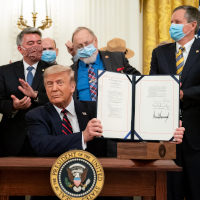
Bi-Partisan Victory for Great American Outdoors Act
View the page for this story
The Great American Outdoors Act addresses years of backlogged expenses for buildings and roads in the National Park system and ensures nearly a billion dollars in yearly funding for conservation of public spaces. Living on Earth’s Paloma Beltran reports on the remarks made by leading Democrats and Republicans at their separate events marking the bill’s passage by a veto-proof majority and signing by the President. (06:14)
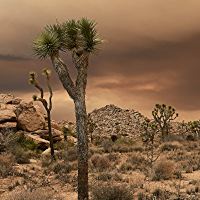
Funding the National Parks, Finally
View the page for this story
For years national parks and public lands in the United States have been severely underfunded. The Great American Outdoors Act is set to help turn that around, with billions of dollars to address maintenance backlogs and support new conservation. Linda Bilmes, Senior Lecturer in Public Policy at Harvard University and author of Valuing U.S. National Parks and Programs: America's Best Investment, joined Host Steve Curwood to talk about what this legislation means. (08:29)
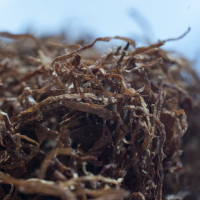
Beyond the Headlines
/ Peter DykstraView the page for this story
It’s Irony Week for this edition of Beyond the Headlines. Environmental Health News Editor Peter Dykstra and Host Steve Curwood discuss major tobacco companies’ pursuit of a tobacco-based vaccine for COVID-19, then move on to discuss the flooding of the last functioning coal mine in Norway by meltwater from a nearby glacier. Finally, Peter and Steve take a trip through history to discuss the connection between the Japanese whaling industry and the horrific U.S. atomic bombing of Hiroshima and Nagasaki 75 years ago. (04:33)
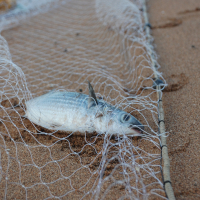
Fishing Fleet Threatens the Galapagos
/ Aynsley O'NeillView the page for this story
Ecuador is on alert after discovering a fleet of more than 200 Chinese fishing vessels near the Galapagos Islands. The famous islands, which helped inspire Charles Darwin’s theory of evolution, are home to the second largest marine reserve in the world. But Ecuadorian officials worry that the fleet’s activity poses a danger to those delicate ecosystems. Ecuador’s former Minister of the Environment Yolanda Kakabadse joins Living on Earth’s Aynsley O’Neill to discuss the situation. (10:10)
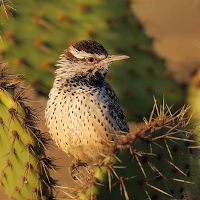
BirdNote®: What Do Desert Birds Drink?
/ Michael SteinView the page for this story
At the height of summer, deserts reach scorching temperatures and water is scarce. But as BirdNote®’s Michael Stein reports, desert birds are well-adapted to the intense heat and dryness. (02:00)

Healthy Buildings Boost Productivity
View the page for this story
Most of us spend 90% of our time indoors, where carbon dioxide levels and ambient chemicals can significantly impact our productivity and cognitive function. Organizations should take note and can see major dividends from improving office air quality, says Joe Allen, Director of the Healthy Buildings Program at Harvard University and author of the book, “Healthy Buildings: How Indoor Spaces Drive Performance and Productivity”. Joe Allen joined Host Steve Curwood at a live online Good Reads on Earth event. (10:34)
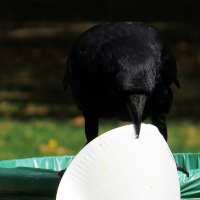
Trying to Train Crows
/ Isaac MersonView the page for this story
Almost everywhere humans are found, so are crows and other corvids. These intelligent birds have found ways to take advantage of the habitats that humans create, and find food and shelter in the shadows and margins. And some members of our own species have seized upon the idea that crows might be taught to help collect litter in exchange for food rewards. Living on Earth’s Isaac Merson takes a look at the viability of these crow-cleaning schemes. (04:59)
Show Credits and Funders
Show Transcript
HOST: Steve Curwood
GUESTS: Joe Allen, Linda Bilmes, Yolanda Kakabadse
REPORTERS: Paloma Beltran, Peter Dykstra, Isaac Merson, Michael Stein
[THEME]
CURWOOD: From PRX – this is Living On Earth.
[THEME]
CURWOOD: I’m Steve Curwood.
The Great American Outdoors Act becomes law, injecting a surge of money into our public lands.
BILMES: It sets up a national park and public lands legacy restoration fund that provides about 9.5 billion dollars over the next 5 years to fix the national parks' deferred maintenance problem.
CURWOOD: Also, outdoor air pollution can affect the productivity of workers inside buildings.
ALLEN: Outdoor air pollution penetrates indoors. And because we spend so much time of our lives indoors, even if that outdoor air pollution is reduced as it comes inside, the majority of your exposure to outdoor air pollution can occur indoors.
CURWOOD: We’ll have those stories and more this week on Living on Earth – Stick Around!
[NEWSBREAK MUSIC: Boards Of Canada “Zoetrope” from “In A Beautiful Place Out In The Country” (Warp Records 2000)]
[THEME]
Bi-Partisan Victory for Great American Outdoors Act
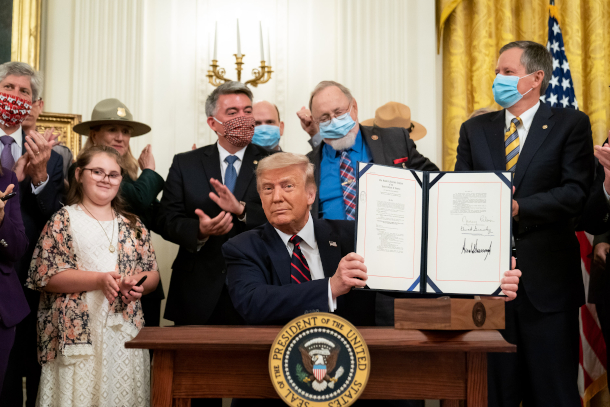
President Trump signed The Great American Outdoors Act in the East Room of the White House. (Photo: Tia Dufour, Flickr, Public Domain)
CURWOOD: From PRX and the Jennifer and Ted Stanley Studios at the University of Massachusetts Boston, this is Living on Earth, I’m Steve Curwood.
On the very last day he could sign the Great American Outdoors Act before it would automatically become law without his signature, on August 4th President Trump put his pen to one of the biggest bi-partisan legislative victories in these times. But the story begins back in April of 2019 when the late civil rights leader and Georgia Democratic Congressman John Lewis originally introduced this multi-billion-dollar measure. It addresses years of backlogged expenses for buildings and roads in the National Park system. It also guarantees that every year close to a billion dollars will be available for conservation and maintenance of public spaces at the federal, state and local level. This June the senate finally agreed, with 73 senators voting in favor. When 310 members of the House voted to accept some Senate amendments on July 22nd, the measure passed with a veto-proof majority. Living on Earth’s Paloma Beltran has more.
BELTRAN: Republican senator Cory Gardner of Colorado set the tone in the East room of the White House during the presidential signing ceremony for the Great American Outdoors Act :
GARDNER: It was 127 years ago, Mr. President in 1893, the Katherine Lee Bates a climbed atop Pikes Peak, and she looked across the plains and mountains of Colorado and wrote the words to America the Beautiful 127 years later, we passed the Great American outdoors Act which will truly protect and provide opportunities for all Americans to enjoy those wonders of this country that Katherine Lee Bates wrote about then.

A video of President Trump went viral after he mispronounced the name of one of the most famous National Parks in the United States, Yosemite National Park, pictured here. (Photo: Edward Stojakovic, Flickr, CC BY 2.0)
This is a remarkable opportunity to celebrate in the midst of acrimony in the midst of partisanship. In the midst of times when the American people probably look out and wonder if they can get anything done. Congress came together to pass the most significant bill, the great American outdoors act in over 50 years with the largest infusion of funding this country has ever seen.
BELTRAN: Despite the bipartisan coalition that got the Great American Outdoors Act through Congress, no Democrats were on the list of speakers invited by President Trump.
TRUMP: The legislation I'm signing today builds on my administration's unwavering commitment to conserving and the grander and the splendor of God's creation. This is truly God's creation.
BELTRAN: But the president struggled with some of the names of the parks.
TRUMP: We want every American child to have access to pristine outdoor spaces. When young Americans experience the breathtaking beauty of the Grand Canyon, when their eyes widen in amazement as Old Faithful bursts into the sky, when they gaze upon Yose-mites, Yosemenites, towering sequoias, their love of country grows stronger. And they know that every American has truly a duty to preserve this wondrous inheritance. And that's what they're doing and that's what we're doing. We're preserving an incredible inheritance.
BELTRAN: Vice President Pence spoke of his familiarity with the national parks under Interior Secretary David Bernhardt.
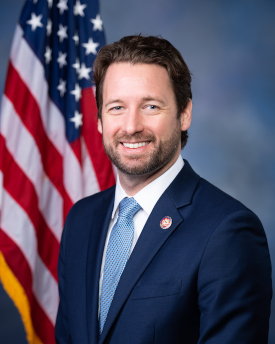
South Carolina Representative Joe Cunningham (D-SC) introduced The Great American Outdoors Act into the House. (Photo: Wikimedia Commons, Public Domain)
PENCE: Mrs. Pence and I have spent a lot of time loading our kids in the minivans driving out, we visited almost every major national park that was the Pence family vacation and I'm proud to say as an early installment of this incredible investment in maintenance, Secretary Bernhardt had the Pence’s actually pounding nails and rebuilding the boardwalk at Old Faithful just last year.
The American people know we have the best national parks in the world. The truth is under the last administration, we saw a backlog of maintenance for all the talk about the environment, we saw projects, left aside and ignored literally $20 billions of work left to be done. I know you'll be happy to know, that this will also we believe, create more than 110,000 infrastructure jobs. As we improve our national parks we're putting Americans back to work.
BELTRAN: House Speaker Nancy Pelosi invited Democratic members of Congress to an enrollment ceremony outside by the Capitol Plaza. Raul Grijalva of Arizona and Chair of the House Committee on Natural Resources, joined her.
GRIJALVA: The set aside for Indian Country to address the urgent maintenance and upkeep needs in Indian schools across Indian country is also part of this legislation that was not noted enough. Let me just say it is historic but it's very very meaningful. My grand babies will be able to look back and say Tata did a very good thing once so I appreciate that. Thank you very much.
BELTRAN: Joe Cunningham a Freshmen from South Carolina also took the podium.
CUNNINGHAM: And we show the American people that despite the ongoing global pandemic and a divided government we can still come together to legislate and pass the most comprehensive package in our lifetime. And you know there is an old saying that we did not inherit this planet from our parents but it's on loan to us by our children. And tomorrow I look forward to flying home and being with my two year old son Boon and taking him to Watertown Park in Downtown Charleston or Pete St. Bridge places green spaces made possible by the Land and Water Conservation Fund. And I look forward to him passing those green spaces and more onto his children and future generations to come. At the end of the day that is what we are all here for.
BELTRAN: And just before she took a pen to formally enroll the passage of the Great American Outdoors Act, Speaker Nancy Pelosi echoed the sentiments of many.
PELOSI: Let me also acknowledge our friends in the environmental community and across the country who've taken an interest in all this for a very, very long time. So with that now, and with great pride and excitement for not only Jo Joe Cunningham's little baby, this is what it's about the future our children but for all of America's children.
BELTRAN: Funds enacted by the Great American Outdoors Act should be available in the next fiscal year, which begins in October. For Living on Earth, I’m Paloma Beltran.
Related links:
- NY Times | “Trump Signs the Great American Outdoors Act”
- Watch the Great American Outdoors Act Presidential Signing Ceremony
- Watch the Great American Outdoors Act Bill Enrollment Ceremony
Funding the National Parks, Finally

Joshua Tree National Park is one of the many parks which will benefit from the Great American Outdoors Act. (Photo: Bob Glennan, Flickr, CC BY NC ND 2.0)
CURWOOD: Despite the celebratory tone both on Capitol Hill and at the White House a number of environmental advocates did not want to give so much credit to the Trump Administration, with its record of rolling back more than 70 environmental regulations. These critics include Linda Bilmes who served in both the Clinton and Obama Administrations. Now a senior lecturer at Harvard’s Kennedy School she has written about the unmet needs of the parks and the economic benefits they provide.
BILMES: Steve, I think one of the great ironies is that a man who has been the worst president for the environment and for conservation, certainly in my lifetime, gets to have his name on the most important piece of conservation legislation in 50 years. I mean, this is a man who has, you know, rolled back protections for national monuments who has slashed Bear Ears National Monument by 80%. And Grand Staircase Escalante, who has weakened the Endangered Species Act, and watershed protections and a wide swathe of environmental rules and regulations. And who has, in particular opened oil and gas drilling across most of U.S. coastal waters. He also ironically, just as recently as February, tried to slash the discretionary funding for the Land and Water Conservation Fund by 97%. And yet, such is the craziness of this pandemic, and FY-2020, that this President will have his name on this very important piece of legislation. It is irony but I think we have to accept that it's a bit of a silver lining of the strange times that we live in.
CURWOOD: I asked Linda Bilmes to outline the provisions of the landmark legislation.
BILMES: And the great American outdoors Act has two main parts. First of all, it sets up a National Park and Public Lands Legacy Restoration Fund that provides about nine and a half billion dollars over the next five years to fix the national parks deferred maintenance problem, and it devotes about $6.5 billion $1.3 billion per year to the national parks maintenance backlog. It also provides about $3 billion dollars to other public lands, such as national forests and wildlife refuges and other federal lands.

Republican Senator Cory Gardner (R-CO) championed The Great American Outdoors Act alongside Democratic Senator Joe Manchin (D-WV). (Wikipedia, Public Domain)
CURWOOD: And talk to me now about the second part of this, this Land and Water Conservation Fund. Why is this Conservation Fund so important and what was its financing for it before?
BILMES: So the Land and Water Conservation Fund was created in 1964. And it's actually a very wonderful and simple idea, which is to take some of the royalties from oil and gas drilling on federal lands in federal waters, and set them aside for conservation of land and waters around the United States, both to the national parks and other federal land agencies and importantly to state and local parks who can apply for matching grants. Now it is authorized for up to $900 million dollars a year which means that's the amount that is actually taken from oil and gasoline synched royalties. But in the past, Congress has only appropriated a small fraction of that amount, in some years, a very, very small fraction to actual land and water conservation. So what this bill will do is it will mandate in perpetuity, that the full $900 million a year goes to the intended purpose, which is conservation on local state and federal lands and waters.
CURWOOD: So this is a bit of inside Washington speak the difference between an appropriation and an authorization. Authorization says, okay, you guys could do this, but appropriation pushes the cash register to go cashing. A question, though, over the near term, then funding is dependent on fossil fuels. Those markets have been fairly volatile at what risk is the government of not getting the royalties necessary to support this program?
BILMES: I think the risk is very low because compared to the overall sums of money involved in oil and gas royalties $900 million a year, although it seems like a fair amount of money, that really is a small fraction of the overall take. You know, the National Parks depends on a variety of funding streams: user fees, appropriations, Land and Water Conservation Fund, money, philanthropy. And this stream is quite variable quite volatile. So the amount of money that is available for any individual Park year to year is volatile. And one of the things that makes managing the national parks very challenging is dealing with this volatile stream of funding. So this at least guarantees that there is a certain amount of funding over the next five years for maintenance and repairs and a certain amount of reliable money through the Land and Water Conservation Fund.
CURWOOD: So this was a bipartisan vote. The bill passed the Senate with 73 - 25 vote and then the House agreed to the Senate version with a 310 to 107 vote. What do you think was the magic sauce here? How did this at bring together Democrats and Republicans?

Linda Bilmes is a Senior Lecturer in public policy at the Harvard Kennedy School and author of Valuing our National Parks: America’s Greatest Investment. (Photo: Diana Bowen/NPS)
BILMES: Well, I think we can thank the very unusual circumstances created by the pandemic, in which three factors the politics, the economics and public opinion converged. First of all, politically, there has been a fair amount of bipartisan support for the national parks and for conservation for many years. However, the particular secret sauce this time was that a number of members of Congress from endangered seats in the West Particularly Senator Steve Daines of Montana and Senator Cory Gardner of Colorado who are facing very stiff challenges from popular Democrats in those states. They championed this and had a meeting with President Trump, in which they said this is a must have, you've got to sign this piece of legislation which has bipartisan support that we are lining up in order for us to have any chance of retaining these Senate seats and for the Republicans having a chance of retaining the Senate. So this became a critical political requirement for the Republican majority and for the majority leader, as well as for a number of senators and congressmen from both parties who have been long champions of the national parks. Secondly, the economics of this great American Outdoors Act is that it will create at least 100,000 good jobs in maintaining and repairing sites, so this was very appealing in the current environment.
CURWOOD: So it's documented that communities of color and Latin X communities aren't seen in the national parks and other public lands at the same rate as white folk. Why is that?
BILMES: There are a couple of factors that explain why there's an over representation of white people in the National Park but the biggest factor is that the average age of a National Park visitor is 63 and the country was less diverse at that time. A second issue is that the National Parks have been at least up until perhaps 20 years ago, they've not been telling everyone's American story. And over the last decade, the National Parks have made a very concerted effort and I think a great deal of progress toward telling the story of all Americans.
CURWOOD: Professor Linda Bilmes is a senior lecturer in Public Policy, Public Finance at Harvard's John F. Kennedy School of Government. Thank you so much for taking the time with us today.
BILMES: Thank you so much. This is such a wonderful program.
Related links:
- NY Times | “Trump Weakens Major Conservation Law to Speed Construction Permits”
- Washington Post | “Trump scales back landmark environmental law”
- NPR | “President Trump Overhauls Key Environmental Law to Speed Up Pipelines and Other Projects”
- Listen to our interview with Linda Bilmes about her book Valuing U.S. National Parks and Programs: America's Best Investment
[MUSIC: Joshua Bell &n Edgar Meyer with Sam Bush & Mike Marshall, “Short Trip Home” on Short Trip Home, by Edgar Meyer, Sony Classical]
CURWOOD: Coming up – a massive Chinese fishing fleet near the Galapagos Islands of Ecuador is raising concerns. That’s just ahead on Living on Earth.
ANNOUNCER: Support for Living on Earth comes from Sailors for the Sea and Oceana. Helping boaters race clean, sail green and protect the seas they love. More information at sailors for the sea dot org.
[CUTAWAY MUSIC: Joshua Bell &n Edgar Meyer with Sam Bush & Mike Marshall, “Short Trip Home” on Short Trip Home, by Edgar Meyer, Sony Classical]
Beyond the Headlines
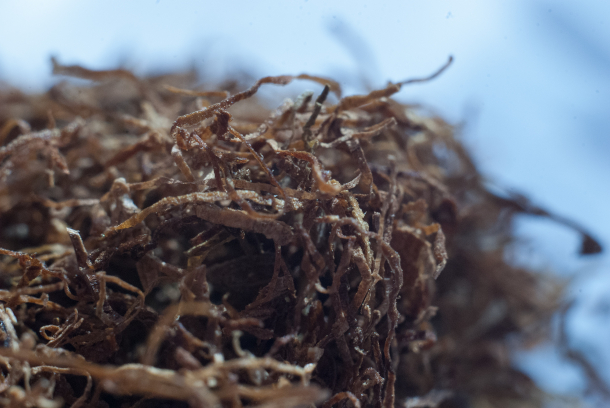
Tobacco products have been linked to many health problems, including lung cancer, which brings a twinge of irony to the news that major tobacco companies are now pursuing tobacco-based vaccines. They hope it will provide a cheap medium for delivery of the viral elements used to generate an immune response. (Photo: Krzysztof Badurek, Flickr, CC by 2.0)
CURWOOD: It's Living on Earth, I'm Steve Curwood.
It's that time of the program when we take a look beyond the headlines with our intrepid guide, Peter Dykstra. Peter's an editor with environmental health news, that's ehn.org and dailyclimate.org, on the line now from Atlanta, Georgia. Hey there, Peter, how you doing and what do you have for us today?
DYKSTRA: Well, hi, Steve. You know, if cable TV can have Shark Week. I think Living on Earth ought to have irony week, and I've got two giant ones to talk us through today.
CURWOOD: Okay, hit me with them.
DYKSTRA: British American Tobacco, the makers of Lucky Strike, is pursuing a tobacco-based COVID-19 vaccine. They'll take a weakened form of Coronavirus, using tobacco as the medium turn it into a vaccine. Other companies like Philip Morris are also pursuing this. British American Tobacco has petitioned the FDA, the Food and Drug Administration, they're awaiting an answer to start clinical trials and they've tried this before with Ebola, with more conventional forms of the flu with very limited results, if any, they're trying again to turn tobacco into a limited version of a hero if it can do anything to help arrest Coronavirus.
CURWOOD: Well, tobacco certainly killed a whole bunch of people, so maybe it might be able to redeem itself this way. What else do you have for us today, Peter?
DYKSTRA: Irony number two, and I love this one. There's a glacier in the Svalbard archipelago, that's in the Arctic part of Norway, land temperatures were 71 degrees in recent weeks there, and it's melting so quickly, that it has flooded and ruined Norway's last functioning coal mine.
CURWOOD: You got to be kidding. Yeah, you're talking about an irony coal responsible for climate disruption is getting rinsed out of the business by melting glaciers. Is this true? Peter, come on, you can tell me .
DYKSTRA: This is the revenge of climate change, this last coal mine in Norway, feeds the last coal burning power plant in Norway. It is out of business now, probably forever flooded by the glacier that covers the mountain that is above the coal mine.
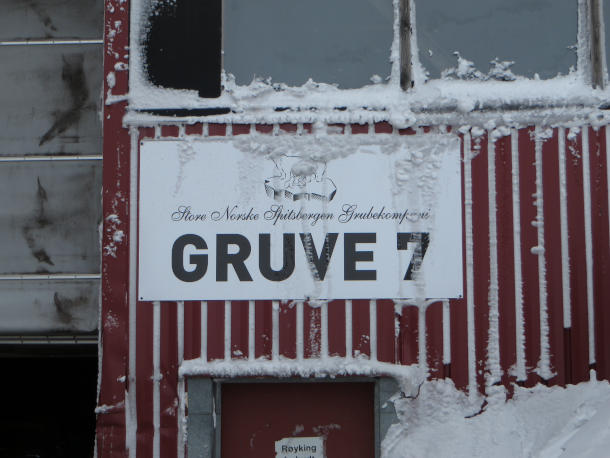
Gruve 7, or Mine 7, was the last coal mine still operating in Norway, before meltwater from the glacier on the mountain above the mine flooded the shaft. The now defunct mine supplied all the coal for the Energiverket power plant in Longyearbyen. (Photo: Bernt Rostad, Flickr, CC BY 2.0)
CURWOOD: So as you're fond of saying, indeed, in this case nature does bat last time huh?
DYKSTRA: It does indeed.
CURWOOD: Okay, history time, Peter, we're in August. What do you see going back in the years?
DYKSTRA: Well, with August 6, of course, we're seeing commemorations of the 75th anniversary of the bombing of Hiroshima. Three days later, the bombing of Nagasaki, deaths in six figures, from those two, an end to World War Two, and just a heart stopping moment in history to hope that we never ever use those bombs again. But here's what happened a year to the day after Hiroshima. General Douglas MacArthur was the military governor of Japan, trying to find ways to peacefully get the shattered nation back on its feet, and a year to the day after Hiroshima, General MacArthur authorized the creation of two industrial scale whaling fleets, to help Japan bring in some cash and get back on its feet.
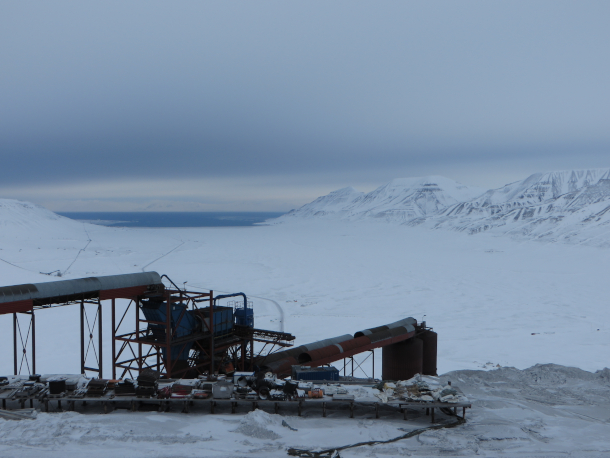
The mine is located in an Arctic region that has been experiencing extremely rapid changes as a result of climate change, with recent temperatures in the region an uncharacteristically balmy 71 degrees Fahrenheit. (Photo: Bernt Rostad, Flickr, CC BY 2.0)
CURWOOD: So what kind of business at this turned out to be?
DYKSTRA: Turned out to be a booming business, obviously a very deadly one for whales. More than two fleets operated in Japan over the next four decades into the 1980s, a little bit beyond, and they wiped out hundreds of thousands of whales, bringing several species that were not yet endangered to the brink of extinction. The International Whaling Commission finally banned industrial whaling in the 1980s, many whale species have yet to recover, and Japan still does smaller scale whaling under the bogus guise of scientific research.

General Douglas MacArthur, acting as the military Governor of Japan following World War II, commissioned two industrial whalers in an effort to kickstart a Japanese economy devastated by the bombings of Hiroshima and Nagasaki. (Photo: Robert Huffstutter, Flickr, CC BY-NC 2.0)
CURWOOD: So Peter, you were talking about irony earlier, is there any irony in this case?
DYKSTRA: There's plenty of irony of course, the tsunami that devastated a big part of Japan north of Tokyo that caused the meltdown at the Fukushima nuclear plant also devastated a whaling port called Ayukama. One of the few whaling ports active in Japan, it took out a big chunk of what was left to the whaling industry in a way that it will probably never recover from.
CURWOOD: Thanks, Peter. Peter Dykstra is an editor with environmental health news. That's eh n.org and daily climate org. We'll talk again real soon.
DYKSTRA: All right, Steve, thanks a lot. Talk to you soon.
CURWOOD: And there's more on these stories on the Living on Earth website. That's LOE.org
Related links:
- Click here to learn more about the effort to develop tobacco-based vaccines
- Learn about how that might work here
- Read more about how climate change doomed Norway’s last functioning coal mine
- Wired | ‘The Japanese Barely Eat Whale. So Why Do They Keep Whaling?’
[MUSIC: CloZee, “Suicide Sheep” on Koto]
Fishing Fleet Threatens the Galapagos

Ecuador is on alert after discovering a fleet of more than 200 Chinese fishing vessels near the Galapagos Islands, raising concerns over indiscriminate fishing practices. (Photo: Ollie Harridge, Flickr, CC NY 2.0)
CURWOOD: Ecuador is on alert after its navy discovered a fleet of more than 200 Chinese fishing vessels near the Galapagos Islands. This famous archipelago that helped inspire Charles Darwin’s theory of evolution is home to the second largest marine reserve in the world. Now, Ecuadorian officials worry that the Chinese fleet poses a danger to those ecosystems by snagging fish that wander out of the formal boundaries of the marine reserve. Yolanda Kakabadse is the former minister of the environment of Ecuador, and she spoke with Living on Earth’s Aynsley O’Neill.
O'NEILL: So, Yolanda, what is the situation right now off the coast of the Galapagos Islands?
KAKABADSE: It's a very delicate concerning reality for Ecuador. There are more than 260 fishing ships, just on the border of the economic zone of Ecuador that surrounds the Galapagos marine reserve and also is off the coast of continental Ecuador.

The Galapagos Islands, a UNESCO World Heritage site, are home to a global hotspot of marine biodiversity. (Photo: Iefetell, Flickr, CC BY-NC-ND 2.0)
O'NEILL: Well, I've actually been lucky enough to spend some time in the Galapagos. And really, it was luck, because those are incredible places. All of those islands, all the ones that I visited, were gorgeous and stunning and so crucial. Could you tell us a little bit about the geography, about the ecosystem, about the wonder that is the Galapagos.
KAKABADSE: I wonder if I can speak a lot about it because all I have is amazement. The first time I went to Galapagos, which was about 50 years or 55 years ago, this sense for the first time in my life that I was another species. Humans in the Galapagos are not on one side of the cordon, the species, the animal in the other side of the cordon. We are just one. And the sense of being another species and being responsible for the care of Galapagos becomes the driving force. Probably that's when I decided to start working on conservation and environment in my life.
O'NEILL: So lots of us know about the Galapagos, let's say from Charles Darwin or from a documentary but what makes them such an important place for Ecuador and the marine environment in general?

A shark swims through the waters off the coast of the Galapagos. In 2017, Ecuador intercepted a Chinese fishing vessel that had illegally entered the Galapagos marine reserve and was carrying 300 tons of marine life, mostly sharks. (Photo: Mary Lide Parker, UNC Marine Sciences, Flickr, CC BY-NC-ND 2.0)
KAKABADSE: To start giving a global vision, oceans are the ecosystems of the world that are most threatened. Overfishing, it has become the garbage site of plastics of the world. Global change, climate change is affecting oceans. So it is an ecosystem that needs a lot of attention from global leaders and all countries around the world. In the specifics, Galapagos is is it the jewel of the crown of this planet. It is a site that not only hosts the most incredible species that are not found in other parts of the world, but it's also a nesting place. It is a place that reproduces several species that guarantee in the medium and long term, the food security that this planet deserves and needs. So it is a site that needs protection. Ecuador has been taking care of the Galapagos protection for six, seven decades. So it is a place that we have tried to preserve as a science spot, as a conservation marine protected area that needs to be protected in order to continue its life forever after. It cannot be threatened as it is now. And already, fishing practices and climate change are affecting the species. So it is not as intact as it was 50 years ago. You can already see that birds and marine species are behaving differently and are not as they were several decades ago.
O'NEILL: And now there's this massive fishing fleet just outside of the exclusive economic zone. What does that mean for the ecosystem? What kind of impact does that have on such a sensitive marine habitat?
KAKABADSE: Well the fishing sector as a whole has to develop even stricter guidelines for fishing. And what we see is that not every fishing fleet or every country has adopted the criteria that is absolutely necessary to control that we keep on having fish forever after. There are several countries that fish in the wrong season with the wrong tools, the wrong size. And what does that mean? That we are not giving the species the necessary time to grow, to reproduce and to continue in the same numbers that we used to have. So what we do have in the Galapagos, on the edge of the Galapagos and the Ecuadorian Economic Zone, is such an enormous fleet, that it is the size of it, that is already a threat. We do hope that the negotiations between Ecuador and China that are being held now will allow Ecuador to have more clarity on what's going on in those ships and hopefully some Ecuadorian observers can visit those ships in order to ensure that tools and size and the amount of fish that has been taken from those seas are the correct ones. But we all know that the fish, know no frontiers, they don't have frontiers. They are migratory species that move in and out of the equatorial economic zone, in and out of the marine reserve. So that is the greatest risk: that that it is not for humans to control that movement. It is for humans to protect them when they move.
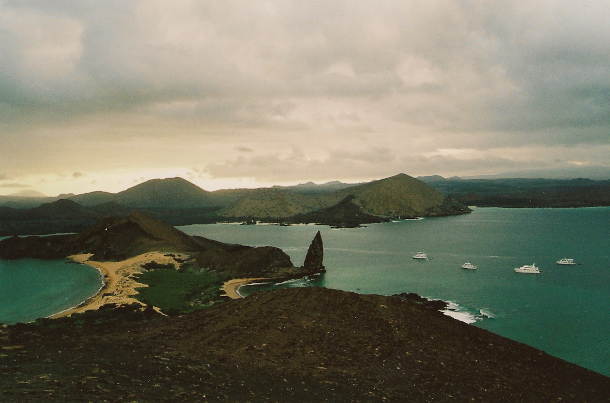
Ecuadorian officials worry that the Chinese fishing fleet’s activity poses a danger to the delicate marine ecosystems of the Galapagos Islands. (Photo: Charlie Zielinski, Flickr, CC BY 2.0)
O'NEILL: Well, could you tell us a little bit more about those international negotiations?
KAKABADSE: What is happening now is that the Minister of Foreign Affairs of Ecuador, who has long experience in international negotiations, is talking to the Chinese government to see how the government can collaborate in the protection of the Galapagos. And one of my points here is that we are holding the next Conference of the Parties of Biodiversity Convention in China. And so that means that China is surely intending to protect its image and protect its interests in being one of the strongest partners of the Convention of Biodiversity, not only within China but around the world. So that is a plus in every sense. And as we know, China has done good things for environment and conservation in China. One cannot deny those efforts. So my hope is that China becomes a partner of Ecuador, and they protects, helps us in the protection efforts of the Galapagos in the economic zone of Ecuador and in the global marine resource as a whole.
O'NEILL: The Ecuadorian government is taking steps to prevent situations like this in the future. Am I correct in saying that?

The Galapagos Islands are home to Sally Lightfoot crabs, among other local keystone species. (Photo: Jeremy T. Hetzel, Flickr, CC BY 2.0)
KAKABADSE: Absolutely. We are working here in Ecuador on other fronts. In that means that we are speaking to the other countries of the South Pacific Coast, Chile, Peru, Colombia, because all of us are facing the same challenges. And I think we all need to have a common strategy. And that is one of the roles that the Ecuadorian government is playing right now in talking to these other countries in order to see that we react with the same policies and the same strategies. The other front in which Ecuador is working very hard is in the creation of a marine protected corridor between Ecuador and Costa Rica. Costa Rica is protecting the islands of Cocos and we are protecting the islands of Galapagos and they are neighbors. The protected areas of Cocos and Galapagos touches on each other and we need to formalize that the existence of that corridor. Up to now we have been protecting the two areas and talking to each other for some years about the importance of creating a four mile corridor, and that will happen in the next few weeks. So in this decade, where we want to have 30% of the marine areas of the world, protected by 2030, it is a beautiful challenge to meet and it is a wonderful opportunity to discuss and agree with the other countries around the world, which other marine areas need to be protected. The moment that sharks and whales and other marine species feel threatened, that relationship will be broken. I think we cannot afford that. The pandemic that we are living today is just a demonstration that that pact is being broken. In the case of the Galapagos, that should be the last place on Earth to be affected by irresponsible actions of any sort. Tourism needs to be sustainable; fishing needs to be sustainable; and any other economic activity, if we want to survive.
CURWOOD: Yolanda Kakabadse is the former minister of the environment of Ecuador speaking with Living on Earth’s Aynsley O’Neill.
Related links:
- The Guardian | “‘They Just Pull Up Everything!’ Chinese Fleet Raises Fears for Galápagos Sea Life”
- BBC News | “Ecuador on Alert Over Huge Chinese Fishing Fleet off Galapagos Islands”
- Hong Kong Free Press | “Hundreds of Chinese Fishing Vessels Descend Upon Galápagos Protection Zone”
BirdNote®: What Do Desert Birds Drink?
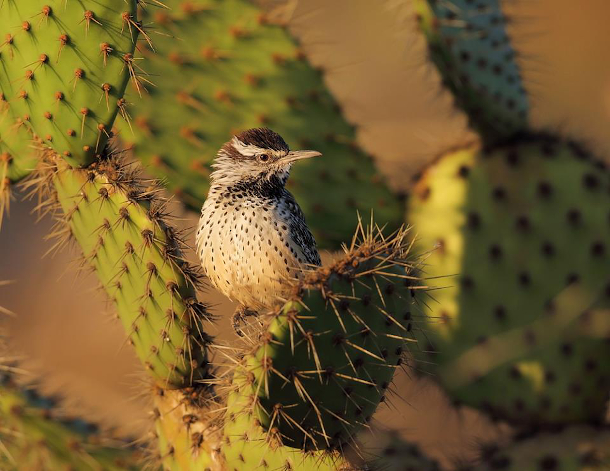
Desert birds like the Cactus Wren make the most of precious little water. (Photo: © Steve Wolfe)
[BIRDNOTE THEME]
CURWOOD: We are in the hot, dog days of summer, here in the northern hemisphere but as BirdNote’s Michael Stein reports for desert birds the searing heat is no problem.
BirdNote®
What Do Desert Birds Drink?
[Desert atmosphere with insect buzz and call of Gambel’s Quail]
In the desert Southwest, summer temperatures sizzle, rising well over 100 degrees. And in some parts of the desert, there is not a drop of water for miles.
Yet some birds thrive in this scorching landscape. Here a Black-throated Sparrow sings from a thorn scrub. [song of Black-throated Sparrow] Now, a Cactus Wren announces itself atop a barrel cactus. [Cactus Wren song] And neither will be flying miles every day to the nearest source of water. So how do they survive?
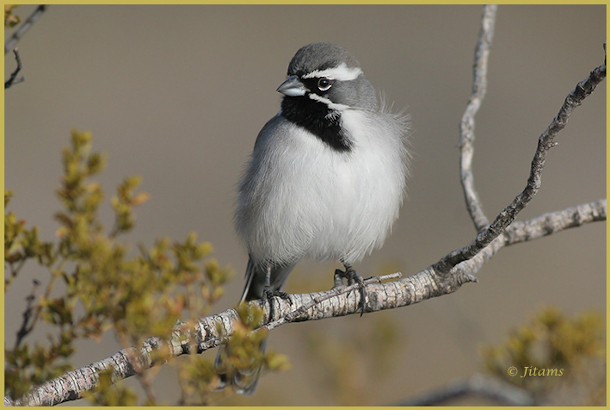
Black-throated Sparrows extract enough water from seeds that they can go a long time without taking a drink. (Photo: © Joanne Kamo)
Birds, like all animals, perish without water. Desert birds, however, make the most of very little. They tuck into the shade in the heat of the day, so they won’t lose water in panting. They have extremely efficient kidneys, so they excrete almost no liquid. And they obtain moisture from foods, like nectar and fruit as well as insects and other prey. [Insect sounds and Black-throated Sparrow song] Even when eating primarily seeds, Black-throated Sparrows are able to extract enough water from this dry food that they may never need to take a drink.
[Thunder storm sounds]
Still, when that next late summer thunderstorm arrives, you have to think those temporary puddles are going to look mighty refreshing.
[Thunder storm sounds, rain and song of Black-throated Sparrows]
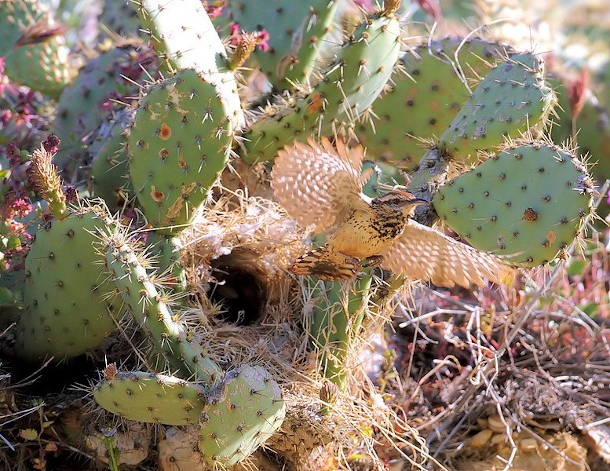
A Cactus Wren takes flight from its nest in a prickly-pear cactus. (Photo: © Steve Wolfe)
Written by Bob Sundstrom
Bird sounds provided by The Macaulay Library of Natural Sounds at the Cornell Lab of Ornithology, Ithaca, New York. Back throated sparrow [50164] and cactus wren [118663] recorded by G. A. Keller.
Desert sounds recorded by Gordon Hempton: dpa desert thunder birds; and Nature Essentials SFX Thunder #7, Rain Aftermath #15, and call of Gambel’s Quail Nature Essentials SFX#136 provided by QuietPlanet.com
BirdNote’s theme music was composed and played by Nancy Rumbel and John Kessler.
Producer: John Kessler
Executive Producer: Chris Peterson
© 2018 Tune In to Nature.org Narrator: Michael Stein
https://www.birdnote.org/show/what-do-desert-birds-drink
CURWOOD: For pictures, fly on over to the Living on Earth website LOE.ORG.
Related links:
- See this story on the BirdNote® website
- Learn more about the Black-throated Sparrow
- Learn more about the Cactus Wren
[MUSIC: The Vignola Collective, “My Back” on Gypsy Grass, by Frank Vignola, Dare Records]
CURWOOD: Coming up – Trying to tap into the scavenging instincts of crows to help clean up our cities. That’s just ahead on Living on Earth.
ANNOUNCER: Funding for Living on Earth comes from you, our listeners, and United Technologies, combining passion for science with engineering to create solutions designed for sustainability in aerospace, building industries, and food refrigeration.
[CUTAWAY MUSIC: The Vignola Collective, “My Back” on Gypsy Grass, by Frank Vignola, Dare Records]
Healthy Buildings Boost Productivity

Several studies assert that increased ventilation in buildings increases worker productivity. (Photo: Pxhere, CC0 1.0)
CURWOOD: It’s Living on Earth, I’m Steve Curwood.
People working from home amid the coronavirus pandemic may actually be working in a safer, healthier, environment. Many offices do not have the best air quality and studies show that fresher, cleaner air, can improve efficiency in workers. If people have more choice to open windows when they work at home, they might do better with their jobs, despite possible distractions from toddlers, teens and television. And getting fresher and cleaner air for offices can mean lower expenses and more net income for businesses. That’s according to Joe Allen. He directs the Healthy Buildings Program at Harvard University and author of the book, “Healthy Buildings: How Indoor Spaces Drive Performance and Productivity.” Joe Allen joined us for an online Good Reads on Earth event, and I asked about his research that correlates building health, air quality and cognitive function.
ALLEN: We have this study known as the cog effect study for cognitive function, where all we did was we took knowledge workers, architects, designers, had them do their normal work routine in a highly controlled environment and take a cognitive function test at the end of the day after working all day with us. What they didn't know is we changed the air, they were breathing in really subtle ways. And it turns out that just changing the air quality, a handful of factors was enough to change their cognitive function performance, their higher order decision making performance in domains that really matter for business, like information seeking and usage, crisis response, strategy, controlling for their individual performance, baseline education. And so controlling for all of these other factors, the building factor in that building signal came through in a double blinded study. And with John Macomber, we make that not leap, we make the argument compellingly and convincingly, I think, that building performance influences human performance influences business performance. So the entire value proposition's wrapped up right there. If you invest a little bit in the building, it pays dividends all the way right to the bottom line of a company.
CURWOOD: Let's talk a little bit in detail about the research how you got these results, people were tested against themselves that is that their ability to perform at under different concentrations of what kind of pollutants?
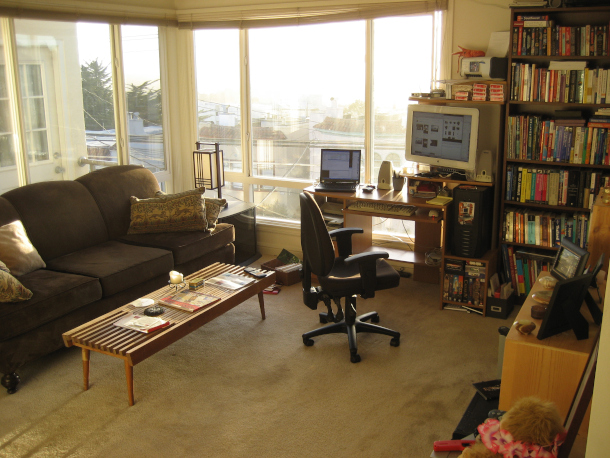
According to Joe Allen, we spend 90% of our lives indoors. (Photo: Danny Howard, Flickr CC BY-NC 2.0)
ALLEN: Yeah, sure. So, you know, we changed just three variables. One is ventilation rate, or really how much fresh outdoor air is coming in. Second variable is carbon dioxide. So indoors humans are the biggest source of carbon dioxide. And third, exposure to common chemicals called VOCs, volatile organic compounds, that off gas from carpets from deodorant from surface cleaners from newly cut wood products from dry cleaning. And so the idea here is we tested levels that people are exposed to all the time. And for ventilation all we do is say what's this minimum level that most buildings are designed to, what happens if you increase that? What's the benefit?
CURWOOD: And by the way, the levels that people were exposed to are all perfectly legal, right? The worst air quality they were subject to was still within various codes and laws, if I understand correctly.
ALLEN: Yeah, I'll put some numbers to it. So indoors, if you're meeting this minimum ventilation standard, which is not we can talk about this in depth, but this carbon dioxide level should be about 900 to 1,000 parts per million. And for reference to ground everybody, outdoor CO2, you know, 400 and rising too fast. Well, in schools 1,500 parts per million in airplanes, we've measured this 1,500 parts per million up to 2,500 parts per million. But to your point about what's legal, the occupational exposure limits, the limits we allow for workers, start at 5,000 parts per million. Point is all of these levels we and we tested 1000 parts per million. We tested a level that nearly all of us are exposed to all the time in your car, in your home, schools. And, you know, not even half of what the current allowable limit is, so we didn't even approach a level that would be even remotely considered dangerous. In fact, it's probably close to that level in the room I'm in right now. And so the key point, I'm glad you brought it up is that, you know, we didn't test exotic conditions. We didn't test some weird chemical exposure, we didn't test some crazy ventilation scenario, we tested conditions that nearly every building can achieve. Right? That every building can achieve these things. A little bit of love on these buildings just a little bit can have these dramatic improvements even beyond infectious disease transmission, headaches and these other symptoms, but actually how well you think.
CURWOOD: Gee, I might ask smarter questions then if I went over and open the window, huh?
ALLEN: Your window must be wide open.
CURWOOD: So then the other part of this equation, though, is that you turn this increased productivity, this ability to think smarter into, well, into dollars and cents that it's literally worth money to people. Talk to me about that part.
ALLEN: Yeah. So in our work in the cog effects study, first thing we did, we knew We'd get this question, well, these improvements must cost something. And sure we modeled this out across the United States, we find the cost for higher ventilation, let's say is on the order of 40 US dollars per person per year. That's normally where the analysis stops. Because people say, well, that's a real expense. And I'm the facilities manager. That's my job. You know, I got to cut costs here. But we factored in the productivity benefits, we estimate the benefits on the order of six to $7,000 per person, right orders of magnitude bigger. Anyway, you model it once you include health in that equation. it overwhelms any of these costs that really are downright trivial at that point.

Joe Allen co-wrote his latest book with business leader John Macomber, a professor at Harvard Business School. (Photo: Courtesy of Joe Allen)
CURWOOD: It says from your study, that people literally in some cases, performed twice as well on some of these tests have they had better ventilation, but then you also write that it's hard in today's environment, to go ahead and capture this say six or $7,000 worth more productivity because there are so many split incentives. I mean, in other words, why might a building owner or manager make these improvements if the benefits which gain in worker health and productivity flow to the tenant?
ALLEN: Yeah, you know, this is the real crux of it. If the equation is so obvious, why isn't it happening? Well, you hit on it, there's these split incentive issues. There's this issue that right, so I'm the building owner, am I gonna make an improvement if you're the company that comes in, you get the benefit. But we make the case in the book that we think there's enough wind to be had, that it can be shared, the owner of the building can charge a premium for it. The tenant organization gets a better building and also gets more productive employees. So there's enough of a win. We're not talking about fine margins here. Right? We're talking about orders of magnitude benefit, and their shared wins to be had.
CURWOOD: Joe, in your book, you start by mentioning that the majority of our exposure to outdoor air actually occurs indoors. Walk us through that place.
ALLEN: Yeah. So in the book, we talk about what we call the dirty secret of outdoor air pollution. And most people don't know this. Right? That The outdoor air pollution penetrates indoors. And because we spend so much time of our lives indoors, even if that outdoor air pollution is reduced as it comes inside, the majority of your exposure to outdoor air pollution can occur indoors. I think people find that entirely shocking. In fact, I challenge anybody to send me a news article, where there's a discussion of outdoor air pollution, and they talk about this dirty secret of indoor air pollution. Every article you'll see will show a picture, maybe a mom walking with her daughter and they're wearing masks and they're outdoors in a polluted city, right? Never once are they on their couch, and that's where they're breathing in a lot of this dirty outdoor air pollution. So it's not talked about it shows the importance, again of the indoor environment and importantly, in well managed buildings, you can reduce the amount of air pollution outdoor air pollution that penetrates indoors and you can break that dirty secret.

Joe Allen is Director of Harvard’s Healthy Buildings program. (Photo: Courtesy of Joe Allen)
CURWOOD: Ah, and you also pointed out that we spent a lot of time indoors.
ALLEN: Yeah. So like it or not, we're an indoor species, Steve. And people don't like to hear that. But we spend 90% of our time indoors. So I'm 44 that means my indoor age is 40. I spent 40 years of my life indoors. And we think about it that way becomes really obvious that the indoor environment has this major impact on our health. But if I asked you or anybody else in the audience, you know, Steve, what does it take to lead a healthy life? You would tell me? Well, Joe, I have to exercise today. I know that. I know what I should eat for dinner a healthy meal, you know, fish is good. I got to limit some other things. And you would tell me out there air pollution is bad. I don't think you are many other people would turn to the indoor environment right away and say, oh, you know what I know the first thing I need to do is take care of the space that's around me. And so it's this glaring hole in our understanding of what it means to live a healthy life. The glaring hole is the indoor environment, the place we spend all of our time.
CURWOOD: Now for decades, the environmental movement has focused on outdoor air pollution and focused on having green buildings that have energy efficiency. But what is the difference now between the healthy building movement and the green building movement? And where's it headed?
ALLEN: Yeah, so the green building movement's been around for, you know, over 20 years, really took off in the mid aughts or so. But it's largely a movement focused on energy waste and water, critically important resource conservation, with a little nod towards maybe the basics of indoor air quality, indoor air quality 101, I'd say in green buildings. But it's been wildly successful, right, it has changed codes and practices and behaviors everyone, many people have seen, let's say a LEED plaque on a building as you walk in announcing its energy efficiency credentials. But that movement is now shifting to one as people start to recognize this 90% we're talking about in our book that healthy buildings, we have to have green energy efficient buildings that are also healthy buildings for the human performance. And so this transition is underway and this new healthy building movement focuses on all these factors that go beyond indoor air quality 101. You know, my healthy buildings program at Harvard releases what we call the nine foundations of a healthy building. And so we get beyond indoor air quality 101. We're thinking about ventilation, air quality, lighting, biophilic design, dusts and pests, water quality, acoustics, all these factors that we know influence health that go beyond what green building rating systems can do. So this is the next version of that. And the market is hungry for it and ready for it and looking for the science that says, what should I do in my building? And then how do I objectively verify and monitor that that's happening and leading to these gains?
CURWOOD: Joe Allen is Director of the Healthy Buildings Program at Harvard and author of the book, “Healthy Buildings: How Indoor Spaces Drive Performance and Productivity."
Related links:
- About Joe Allen
- Joe Allen’s latest book, Healthy Buildings: How Indoor Spaces Drive Performance and Productivity
[MUSIC: Hugh Masekela, “Fela” on Afrobeat…No Go Die! – Trans-Global African Funk Grooves, by Hugh Masekela, Shanachie Records.]
Trying to Train Crows

Most wild Rooks are more likely to take garbage OUT of the can. (Photo: Josefine S., Flickr, CC BY-NC-ND 2.0)
CURWOOD: The animal species that share our cities and suburbs and are able to adapt to living near humans are often called pests. Crows are often noisy and sometimes annoying, but they are among the smartest birds. So some crow entrepreneurs are looking at ways to train them to actually help clean up our city streets. Living on Earth’s Isaac Merson has our story.
MERSON: Six crows circle, deep black against the bright sky.
[SFX Rook calls, from the the Macaulay Library]
MERSON: One flies lower, lands, cocks her head, and dips her bill to snatch up a cigarette butt, a tiny piece of plastic litter containing as many as 250 toxic chemicals. The crow flies to an intricate mahogany box and deposits the cigarette butt. Her Trainer pulls a drawer out, with a tasty treat inside. The crow scarfs her snack and takes to the skies in search of more treasured trash.
Large-billed crows in Japan are no strangers to using humans to grab an easy meal. (Photo: Isaac Merson)
[SFX Rook wing sounds from the Macaulay Library ]
MERSON: Our heroine is one of six rooks trained by Christophe Gaborit at the Puy du Fou theme park in France to pick up litter in return for a delicious snack. This winged troop swoops and scoops, black eyes full of glee and trickery. Think of the possibilities this suggests! A corvid army of crows cleaning our streets, collecting loose change, sorting our recycling, spit shining our sidewalks.
[SFX Chorus of crow sounds from the Macaulay Library ]
Crows live on every continent except Antarctica. Their global distribution is a testament to their ability to problem solve; here a Pied Crow stalks the grasses of Northern Tanzania. (Photo: Isaac Merson)
MERSON: We know that crows are smart, they learn from one another, and can even pass knowledge down from one generation to the next. They make and use tools include ing busy roadways to crack walnuts. And some Large-billed crows in Japan have been found building indestructible nests from discarded coat-hangers. In a TED talk technologist Josh Klein, talked about the idea that crows might be convinced to help clean up the messes that we make:
KLEIN: I think that crows can be trained to do other things, for example, why not train them to pick up garbage after stadium events or find expensive components from discarded electronics?
Crows have even found their way to small pacific islands, like this Mariana Crow, one of fewer than 200 individuals remaining from its species. (Photo: Isaac Merson)
MERSON: And the internet is chock full of wild speculation about the future possibilities suggested by the staged presentations in France. One dutch start-up, called Crowded Cities, spent several years developing a combination trash can and automatic food dispenser called the Crowbar which would reward wild crows with peanuts or food pellets upon successful deposit of a cigarette filter. But research suggests wild Crows probably don’t want to do our dirty work for peanuts. In fact, not one single experiment with wild crows has been able to document a desire to trade trash for rewards. According to corvid expert Dr. Jennifer Campbell Smith, any kind of training like this would most likely only work with captive crows, who are receptive to training primarily because they get bored and want to play.
CAMPBELL-SMITH: These are animals that don't have to worry about where their next meal comes from. They don't really have to worry about predators. So they get bored. They need cognitive stimulation, and they're quite open to training. Wild crows are a generalist forger that is having to look out for predators, that is having to worry about where its next meal comes from. And honestly, it has easy access to food from sidewalks dumpsters landfills. Honestly, there's plenty of insects in the grass. peanuts and food pellets really wouldn't justify the time and risk that they would have to give up in order to clean up trash for us.
MERSON: So perhaps wild crows aren’t the street cleaners of tomorrow. Perhaps we need to find ways to coexist by thinking less like a human, and more like a crow. After all, there’s no getting away from our fellow intelligent generalists, they’re already using humans to supply a lot of their food, taking free lunch from landfills, roadkills, and take-out spills, and using the trees we plant in our suburbs for shelter. When we look at a crow and see an opportunity to exploit, the crow is staring right back at us. And if we think like a crow, we may stand to benefit: healthy relationships between humans and corvids exist, and have for a long time: Alaskan Athabascan and Inupiac peoples follow the gurgling calls of ravens to find game, and leave the carcass for the raven in return. And that’s something to crow about.

Not all inter-species hunting relationships are cordial; here a grizzly warns away a hungry raven from a sheep carcass. (Photo: Keith Williams, Flickr, CC BY-NC 2.0)
[SFX: Crow sounds from the Macaulay Library ]
MERSON: For Living on Earth, I’m Isaac Merson.
Related links:
- Watch the Puy du Fou crows in action
- Read more about some of the different ways people of the world regard crows
- Read more about what experts had to say about the idea
[MUSIC: Richard Stoltzman/Kalmen Opperman, “Blackbird/Bye Bye Blackbird” on Dreams, Lennon/McCartney and Ray Henderson/Mort Dickson/arr.Stoltzman, RCA Red Seal]
CURWOOD: Living on Earth is produced by the World Media Foundation. Our crew includes Naomi Arenberg, Bobby Bascomb, Paloma Beltran, Jenni Doering, Jay Feinstein, Anne Flaherty, Don Lyman, Isaac Merson, Aynsley O’Neill, Jake Rego, Kori Suzuki, and Jolanda Omari. Tom Tiger engineered our show. Alison Lirish Dean composed our themes. You can hear us anytime at L-O-E dot org, Apple Podcasts and Google Podcasts, and like us, please, on our Facebook page - Living on Earth.
We tweet from @livingonearth. And find us on Instagram at livingonearthradio. I’m Steve Curwood, Thanks for listening!
ANNOUNCER: Funding for Living on Earth comes from you, our listeners, and from the University of Massachusetts, Boston, in association with its School for the Environment, developing the next generation of environmental leaders. And from the Grantham Foundation for the protection of the environment, supporting strategic communications and collaboration in solving the world’s most pressing environmental problems.
ANNOUNCER 2: PRX.
Living on Earth wants to hear from you!
Living on Earth
62 Calef Highway, Suite 212
Lee, NH 03861
Telephone: 617-287-4121
E-mail: comments@loe.org
Newsletter [Click here]
Donate to Living on Earth!
Living on Earth is an independent media program and relies entirely on contributions from listeners and institutions supporting public service. Please donate now to preserve an independent environmental voice.
NewsletterLiving on Earth offers a weekly delivery of the show's rundown to your mailbox. Sign up for our newsletter today!
 Sailors For The Sea: Be the change you want to sea.
Sailors For The Sea: Be the change you want to sea.
 The Grantham Foundation for the Protection of the Environment: Committed to protecting and improving the health of the global environment.
The Grantham Foundation for the Protection of the Environment: Committed to protecting and improving the health of the global environment.
 Contribute to Living on Earth and receive, as our gift to you, an archival print of one of Mark Seth Lender's extraordinary wildlife photographs. Follow the link to see Mark's current collection of photographs.
Contribute to Living on Earth and receive, as our gift to you, an archival print of one of Mark Seth Lender's extraordinary wildlife photographs. Follow the link to see Mark's current collection of photographs.
 Buy a signed copy of Mark Seth Lender's book Smeagull the Seagull & support Living on Earth
Buy a signed copy of Mark Seth Lender's book Smeagull the Seagull & support Living on Earth

